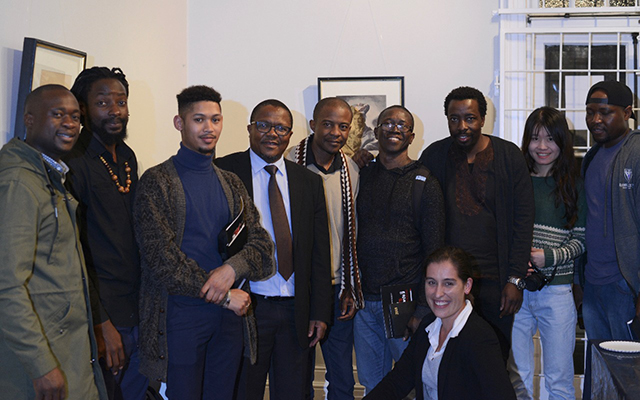Writing: Reviews & Think Pieces
Conversations around the Fort Hare Artistic Collection and the Umtiza Arts Festival, 2018
The 2018 Umtiza festival, the 3rd in the series was held from Thursday May 24 to Sunday May 27. An important aspect of historical magnitude of this year’s festival was an exhibition of select works from the prestigious Collection, which is housed at the University of Fort Hare in Alice. The exhibition comprises works by black artists from the 1940s and 60s including George Pemba (1912 – 2001) and Gerard Sekoto (1913 – 1993). Other notable artists’ works included in this display were Dumile Mhlaba, Bhengu Gerrard, and James Mhahlele.
Of interest here are these historic collections of paintings, drawings and prints from Fort Hare University which has been erroneously called the ‘De Beers Collection’ over the years. This was further complicated by Leon du Preez, the curator of the Ann Bryant Art Gallery, during the opening of the show. According to him, “The De Beers Collection is a top collection of prominent black artists. Because it is situated in Alice, not everyone gets to see it, but this is our opportunity to view these works.” Perhaps a historical misadventure here is the labelling of this collection as ‘De Beers Collection’ not only by the curator but also by the Vice Chancellor of the Fort Hare University. Correcting that impression and inappropriate historical context, Vuyani Booi, also from the University of Fort Hare says it is unfortunate that these works are always described in the context of ‘De Beers Family’ whose only contribution in 1989 was to donate ‘De Beers Centenary Art Gallery’ to house the works of art by the University. One readily feels that the donation of the gallery by the De Beers family was a form of restitution, a ‘feel sorry’ gesture for their negative attitude towards blacks and contribution to the apartheid legacy in pre-democratic South Africa. Booi was therefore of the opinion that such pronouncements must be corrected with the need for a proper historical exposition on the entire collection at the Fort Hare University.
That being said, it was an interesting and historically significant exhibition that brought together for the first time in many years a fraction of this prestigious collection. The history of the collection can be traced to Prof Zachariah Keodirelang "ZK" Matthews (1901 – 1968) who was the Director of the African Studies from 1944. "ZK", as popularly called, was himself an active member of the ANC and actively participated in many of the struggles for democracy in his own capacity. According to Booi, he started the collection of many of the works of art in the early 1940 until he went on exile in 1952 and eventually retired from the University.
Declaring the show opened, Councillor Mawethu Marata of the Buffalo City Municipality spoke of the support given by the Department of Art and Culture towards the festival. Prof Sakhela Buhlungu the Vice Chancellor of the Fort Hare University, also provided a succinct historical background to the over 2500 collection of art works, adding that any respectable university should have artistic collection. Art, he says, builds up a history and it reveals the substance, struggles and experiences that constitute society. He therefore challenged parents not to be guilty of living vicariously through the lives of their children by forcing them to take to professions in medicine, engineering and accounting. Speaking about the collection, Prof Buhlungu said all paintings there had been kept in storage and had never been exhibited like many of the works in the collection due to the small size of De Beers Gallery in Alice. The works are a generational shift from old to new artists. Many of these artists were pioneer self-taught artists who were sympathetic to the struggle for liberation and human rights struggles in South Africa. The exhibition presents in the different media the story of the struggle and their encounter with the daily life that was not often seen outside of South Africa. Many of these artists have not been researched to actually see the extent of their works and influence in recording of the daily life struggles of the black man in apartheid South Africa. Whilst the quality and the importance of these works of art on display in this exhibition is not in doubt, the curatorial management of the show was not very impressive, one expected to see a more historically correct narrative of the show, as well as textual materials that could have provided better information about the works and the artists. This sort of disservice robs the show of its historical relevance as an important threshold in the history of pre-democratic South Africa.
Key Words: Umtiza Festival; Fort Hare University; De Beers Gallery; George Pemba; Gerard Sekoto

Photo: Prof Sakhela Buhlungu, the Vice Chancellor of the Fort Hare University, with members of the Arts of Africa and Global South Group, Rhodes University, during the exhibition. From left Wallen Mapondera, Aaron Mulenga, Brun Kramer, The VC Forth Hare, Andrew Mulenga, Stephen Folaranmi, Stary Nwaba, Lifang Zhang and Ticha. Front row is Natasha Bezuidenhout Photograph by Stary Nwaba, 2018
Dr Stephen Folaranmi is a Post-Doctoral Fellow with the NRF/DST SARChI Chair Geopolitics and the Arts of Africa, Arts of Africa and Global Souths research programme headed by Prof Ruth Simbao at the Department of Fine Arts, Rhodes University, South Africa.
Last Modified: Tue, 12 Feb 2019 09:25:08 SAST
